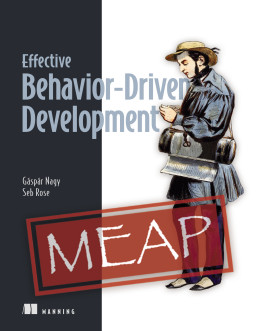pro $24.99 per month
- access to all Manning books, MEAPs, liveVideos, liveProjects, and audiobooks!
- choose one free eBook per month to keep
- exclusive 50% discount on all purchases
- renews monthly, pause or cancel renewal anytime
lite $19.99 per month
- access to all Manning books, including MEAPs!
team
5, 10 or 20 seats+ for your team - learn more

Look inside
Emerging practices, collaboration tools, and effective techniques for incorporating your key stakeholders into the software design process.
Don’t spend months building the wrong software! Collaborative Software Design is a unique and practical guide for effectively involving all stakeholders in the design of software to ensure sustainable design decisions.
In Collaborative Software Design you’ll learn how to:
Collaborative Software Design combines its authors’ deep experience in behavioral science, decision-making theory and software architecture into an essential guide for making collaborative design decisions. You’ll learn to use process visualizations, engaging sessions, and social dynamic management to ensure every stakeholder is contributing their vital insights to a project. Best of all, the skills you’ll learn make it easy for software teams to develop software directly with their stakeholders—no need to rely on a centralized or top-down design.
Don’t spend months building the wrong software! Collaborative Software Design is a unique and practical guide for effectively involving all stakeholders in the design of software to ensure sustainable design decisions.
In Collaborative Software Design you’ll learn how to:
- Prepare and facilitate collaborative modeling sessions with tools such as Business Model Canvas, Event Storming, Domain Storytelling, Example Mapping, and Wardley Mapping
- Pick and apply heuristics for modeling software design
- Techniques for getting all needed knowledge from the group
- The influence of ranking
- The impact and opportunities of cognitive bias
- Resistance and conflict resolution
- Practices for following up after a modeling session
- Document the session and report to stakeholders
Collaborative Software Design combines its authors’ deep experience in behavioral science, decision-making theory and software architecture into an essential guide for making collaborative design decisions. You’ll learn to use process visualizations, engaging sessions, and social dynamic management to ensure every stakeholder is contributing their vital insights to a project. Best of all, the skills you’ll learn make it easy for software teams to develop software directly with their stakeholders—no need to rely on a centralized or top-down design.
about the technology
Delivering high-quality software requires the active participation of all stakeholders in the design process. But how do you align individuals with different roles, perspectives, and priorities to create sustainable software? Collaborative Software Design presents proven strategies that you can use to foster productive decision making, resolve conflicts and uncertainties, and elevate the quality of design outcomes.about the book
In Collaborative Software Design, you’ll explore principles, techniques, and tools to promote safe communication as you discover business problems, formalize requirements, and implement a software project. It highlights established collaborative modeling tools like Event Storming, Example Mapping, Wardley Mapping, and Domain Storytelling, and introduces unique approaches for managing cognitive biases, conflict, and organizational hierarchy. Whether you’re a business stakeholder, a technical contributor, or a professional facilitator, you’ll learn how to hear and benefit from every voice in the room.what's inside
- Prepare and lead collaborative modeling sessions
- Turn conflict into innovation
- Make sustainable software design decisions
- Improve software design from a sociotechnical perspective
Encourages you to provide leadership by experience and example.
Provides the tools, techniques, heuristics, and perspectives every manager should have.
It is written well and easily understood.
Leverage your group’s strengths, manage conflicts, and make good decisions on what to build!
choose your plan
team
monthly
annual
$49.99
$399.99
only $33.33 per month
- five seats for your team
- access to all Manning books, MEAPs, liveVideos, liveProjects, and audiobooks!
- choose another free product every time you renew
- choose twelve free products per year
- exclusive 50% discount on all purchases
- renews monthly, pause or cancel renewal anytime
- renews annually, pause or cancel renewal anytime
-
![]() Collaborative Software Design ebook for free
Collaborative Software Design ebook for free
choose your plan
team
monthly
annual
$49.99
$399.99
only $33.33 per month
- five seats for your team
- access to all Manning books, MEAPs, liveVideos, liveProjects, and audiobooks!
- choose another free product every time you renew
- choose twelve free products per year
- exclusive 50% discount on all purchases
- renews monthly, pause or cancel renewal anytime
- renews annually, pause or cancel renewal anytime
-
![]() Collaborative Software Design ebook for free
Collaborative Software Design ebook for free
choose your plan
team
monthly
annual
$49.99
$399.99
only $33.33 per month
- five seats for your team
- access to all Manning books, MEAPs, liveVideos, liveProjects, and audiobooks!
- choose another free product every time you renew
- choose twelve free products per year
- exclusive 50% discount on all purchases
- renews monthly, pause or cancel renewal anytime
- renews annually, pause or cancel renewal anytime
-
![]() Collaborative Software Design ebook for free
Collaborative Software Design ebook for free


















 Collaborative Software Design ebook for free
Collaborative Software Design ebook for free